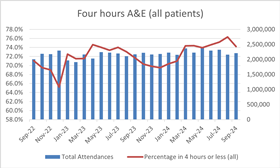- Ambulance response times drop in latest month
- Urgent care also deteriorates after months of steady improvement
- NHS England highlights record demand
Ambulance response times rose sharply and emergency care performance also worsened last month as the NHS moves towards what will be a challenging winter.
Ambulance ’category 2’ performance dropped to 36 minutes 2 seconds – far worse than August when it was well under the government’s 30m target at 27m 25s.
September’s performance was marginally better than September 2023 when it was 37m 39s, but it is looking increasingly unlikely that the sector will hit its target to meet 30m as an average this year.
Category 1 performance – for the most serious emergencies - also declined to 8m 25s, just six seconds better than September 2023 and far above the 7m target.
Ambulance trusts are increasingly splitting into two groups with a number meeting the category 2 target – North East Ambulance Service, North West Ambulance Service, South East Coast Ambulance Service and West Midlands Ambulance Service – while a number of others are over 40m: East Midlands and East of England, London and South Central.
LAS has agreed to a 36m category 2 response time with its commissioners but was significantly outside it this month at 42m 27s – the second-worst performance of all ambulance trusts. It has seen significantly increased demand over the past year – up around 9 per cent.
LAS chief executive Daniel Elkeles said the trust had seen an increase in calls compared with September last year. “As the weather turned colder and schools reopened, we saw a surge in respiratory infections and growing pressure on hospitals. Our control room colleagues have continued to help our road crews reach our sickest patients as quickly as possible with our category 1 times the second fastest in the country. We also remained conscious of vulnerable patients needing a category 3 response,” he added.
“However, we recognise there is more we must do to improve our response times as we approach winter.”
One small glimmer of hope for ambulance services was that the percentage of cases resolved on the phone was the highest since new definitions were introduced in 2017 at 15.5 per cent.
Worsening performance in emergency care
Urgent and emergency care got demonstrably worse over several metrics in September – marking the first downturn in performance for several months.

Four hours A&E had been improving steadily since May but the 74.2 per cent performance in all urgent care settings in September was down from 76.3 per cent in August. For major A&Es only, four hours deteriorated from 62.5 per cent in August to 59.8 per cent in September.
In September, 129,012 A&E attendances waited 12 hours or more, up from 113,927 in the previous month. It was the highest proportion of total attendance (9.7 per cent) since May.
The five trusts where patients were most likely to wait 12 hours or more in A&E in September were all in the North West. At Blackpool Teaching Hospitals Foundation Trust, Countess of Chester Hospital FT, Wirral University Teaching Hospital FT, Wrightington, Wigan and Leigh FT and Warrington and Halton FT – at least one in five A&E patients waited more than 12 hours.
In the first six months of 2024-25, there have been 795,411 12-hour A&E waits – a 25 per cent rise from the 637,870 long waits in the same period last year.
Long waiters’ target will be missed
The overall waiting list remained broadly flat between July and August at 7.6 million – the level at which it has plateaued for the last five months.
Long waiters, those waiting over 65 weeks, fell by around 5,300 from 50,900 to around 45,500 in August.
However, NHSE is set to miss its target to “virtually eliminate” 65-week breaches by September, confirmation of which will be available in next month’s data.
The news comes with senior NHS figures raising concerns to HSJ that ministers are considering “capping” the £3.2bn elective recovery fund this year, in a move they warned could derail Labour’s pledge to cut waiting lists and send NHS finances into further disarray, as revealed by HSJ this morning.
‘Pressure continues,’ says NHSE
NHSE said staff in A&E experienced their busiest ever September with 2.21 million attendances, and 530,824 emergency admissions, which followed the busiest summer on record. However, analysts have pointed out that an “exit block” caused by poor patient flow has a more direct impact on A&E performance.
On elective care, NHSE added staff had delivered 11.96 million treatments so far this year, which was 570,263 more than the same period in 2019.
Professor Sir Stephen Powis, NHSE national medical director, said: “We know this is likely to be another incredibly busy winter, with extra demand and the threat of a “tripledemic” of covid, flu and RSV, and last month we set out our winter plan which included better data reporting and more care in the community like falls services and virtual wards, so we can see patients as quickly as possible in the busy months ahead.”
Source
NHSE data
Source Date
October 2024
Topics
- Ambulance
- BLACKPOOL TEACHING HOSPITALS NHS FOUNDATION TRUST
- COUNTESS OF CHESTER HOSPITAL NHS FOUNDATION TRUST
- East Midlands
- East Midlands Ambulance Service NHS Trust
- East of England
- East Of England Ambulance Service NHS Trust
- London
- London Ambulance Service NHS Trust
- North East
- North East Ambulance Service NHS Trust
- North West
- North West Ambulance Service NHS Trust
- Performance
- South
- South East Coast Ambulance Service NHS Foundation Trust
- Warrington and Halton Hospitals NHS Foundation Trust
- WIRRAL UNIVERSITY HOSPITAL NHS TRUST
- WRIGHTINGTON, WIGAN AND LEIGH NHS TRUST



























12 Readers' comments